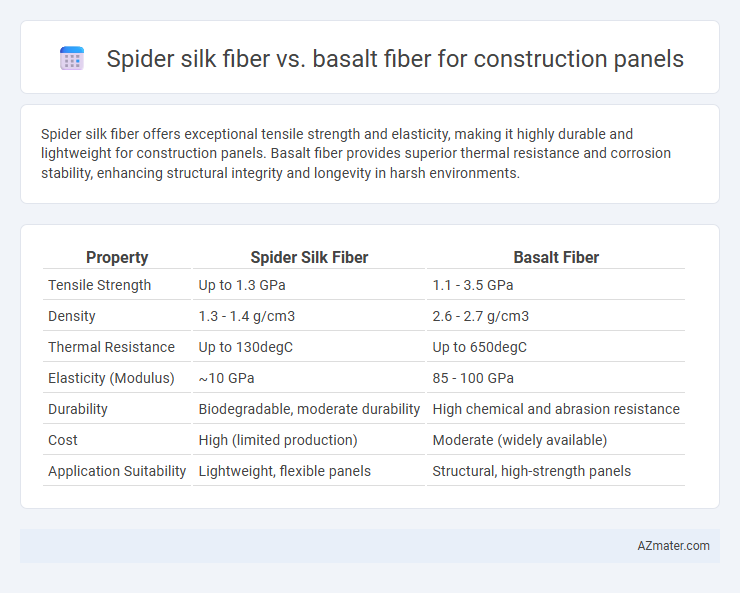Spider silk fiber offers exceptional tensile strength and elasticity, making it highly durable and lightweight for construction panels. Basalt fiber provides superior thermal resistance and corrosion stability, enhancing structural integrity and longevity in harsh environments.
Table of Comparison
| Property | Spider Silk Fiber | Basalt Fiber |
|---|---|---|
| Tensile Strength | Up to 1.3 GPa | 1.1 - 3.5 GPa |
| Density | 1.3 - 1.4 g/cm3 | 2.6 - 2.7 g/cm3 |
| Thermal Resistance | Up to 130degC | Up to 650degC |
| Elasticity (Modulus) | ~10 GPa | 85 - 100 GPa |
| Durability | Biodegradable, moderate durability | High chemical and abrasion resistance |
| Cost | High (limited production) | Moderate (widely available) |
| Application Suitability | Lightweight, flexible panels | Structural, high-strength panels |
Introduction to Spider Silk Fiber and Basalt Fiber
Spider silk fiber, known for its exceptional tensile strength and elasticity, offers lightweight and biodegradable properties ideal for sustainable construction panels. Basalt fiber, derived from volcanic rock, provides superior thermal resistance, high durability, and cost-effective reinforcement for structural applications. Comparing these materials highlights spider silk's eco-friendly advantages against basalt fiber's robustness and thermal stability in construction panel manufacturing.
Composition and Structure of Spider Silk Fiber
Spider silk fiber, composed primarily of fibroin proteins with repetitive amino acid sequences like glycine and alanine, exhibits a unique hierarchical structure featuring crystalline b-sheet nanocrystals embedded in an amorphous matrix, providing exceptional tensile strength and elasticity. Basalt fiber, derived from volcanic rock and composed mainly of silica, alumina, and iron oxide, has a rigid, glass-like microstructure that offers high thermal and chemical resistance but lacks the flexibility of spider silk. The protein-based molecular architecture of spider silk enables superior toughness and lightweight properties beneficial for advanced construction panels compared to the brittle, mineral-based basalt fibers.
Composition and Structure of Basalt Fiber
Basalt fiber, derived from volcanic basalt rock, consists primarily of silicon dioxide (SiO2), aluminum oxide (Al2O3), and iron oxide (Fe2O3), creating a naturally heat-resistant and chemically stable composition. Its continuous filament structure exhibits high tensile strength and excellent durability, making it well-suited for reinforcing construction panels. Unlike spider silk fiber, which is a protein-based biological material known for its elasticity and lightweight nature, basalt fiber provides superior rigidity and thermal resistance essential for structural applications.
Mechanical Strength Comparison
Spider silk fiber exhibits exceptional tensile strength, reaching up to 1.3 GPa, surpassing many synthetic fibers used in construction panels. Basalt fiber offers high compressive strength around 2.5 GPa and excellent thermal stability, making it suitable for structural reinforcement. Comparing both, spider silk provides superior flexibility and toughness, while basalt fiber excels in rigid load-bearing applications and resistance to environmental degradation.
Durability and Environmental Resistance
Spider silk fiber exhibits exceptional durability and environmental resistance due to its high tensile strength, elasticity, and natural resistance to moisture and UV radiation, making it ideal for long-lasting construction panels. Basalt fiber offers superior resistance to heat, chemical corrosion, and weathering, ensuring structural integrity in harsh environmental conditions. Both fibers provide sustainable, eco-friendly alternatives to traditional materials, with spider silk excelling in flexibility and impact resistance, while basalt fiber is advantageous for thermal and chemical stability.
Insulation Properties: Thermal and Acoustic
Spider silk fiber exhibits superior acoustic insulation properties due to its natural protein structure, effectively dampening sound vibrations in construction panels. Basalt fiber offers excellent thermal insulation, with a high melting point around 1450degC and low thermal conductivity, making it ideal for heat resistance in building materials. Combining spider silk's sound absorption with basalt fiber's thermal stability enhances multifaceted insulation performance in construction panels.
Sustainability and Environmental Impact
Spider silk fiber offers exceptional sustainability due to its biodegradability, renewable sourcing, and minimal ecological footprint in production, making it an environmentally friendly alternative for construction panels. Basalt fiber, derived from abundant natural volcanic rocks, provides high durability and recyclability, reducing reliance on synthetic fibers but involves energy-intensive manufacturing processes that increase its carbon footprint. Choosing spider silk fiber can significantly lower environmental impact by promoting renewable materials and reducing waste, while basalt fiber supports sustainability through its natural origin and potential for reuse in construction applications.
Cost and Availability for Construction
Spider silk fiber is significantly more expensive and less available than basalt fiber, limiting its practical use in construction panels. Basalt fiber, derived from volcanic rock, offers a cost-effective alternative with widespread availability, making it suitable for large-scale construction applications. Its affordability and abundant supply ensure consistent production without the supply chain constraints faced by spider silk fiber.
Application Performance in Construction Panels
Spider silk fiber exhibits exceptional tensile strength and flexibility, making it ideal for lightweight construction panels that demand high impact resistance and durability. Basalt fiber offers superior thermal stability, chemical resistance, and fire retardancy, enhancing panel longevity and safety in extreme environmental conditions. Combining these fibers can optimize panel performance by balancing mechanical strength with environmental resilience in modern construction applications.
Future Prospects and Innovations
Spider silk fiber exhibits exceptional tensile strength, flexibility, and biodegradability, making it a promising material for future construction panels with enhanced durability and sustainability. Basalt fiber offers superior thermal stability, chemical resistance, and cost-effectiveness, driving innovations in eco-friendly, high-performance composite panels. Advances in bioengineering and nanotechnology are expected to improve the scalability and functionality of spider silk and basalt fibers, revolutionizing lightweight, sustainable construction materials.

Infographic: Spider silk fiber vs Basalt fiber for Construction panel
 azmater.com
azmater.com